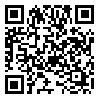Volume 10, Issue 3 (9-2019)
JAP 2019, 10(3): 53-70 |
Back to browse issues page
Download citation:
BibTeX | RIS | EndNote | Medlars | ProCite | Reference Manager | RefWorks
Send citation to:



BibTeX | RIS | EndNote | Medlars | ProCite | Reference Manager | RefWorks
Send citation to:
Manshaee G, Yazdanfar M, Ghamarani A. Determination and Fitting of Emotional Regulation Strategies Model on the Basis of Attachment Dimensions in Patients with Rheumatoid Arthritis
. JAP 2019; 10 (3) :53-70
URL: http://jap.iums.ac.ir/article-1-5434-en.html
URL: http://jap.iums.ac.ir/article-1-5434-en.html
1- khorasgan Branch, Islamic Azad University, Esfahan
2- Department of Psychology, Isfahan University, Esfahan ,aghamarani@yahoo.com
2- Department of Psychology, Isfahan University, Esfahan ,
Abstract: (2056 Views)
Aims and background: The aim of the present study was determination and fitting of emotional regulation strategies model on the basis of attachment dimensions in patients with rheumatic arthritis. Materials and methods: This research is descriptive and correlation. The study statistical population included all the patients with rheumatic arthritis referred to Imam Khomeini hospital and clinics related to health of Tehran who overall, 300 patients were selected through available sampling based on specialist diagnosis. The instrumentals of this study were attachment dimension scale, cope scale, social self-efficacy scale, dysfunctional reactions questionnaire and distress disclosure index who participants completed. Data were analyzed using AMOS software and structural equation modeling. Findings: The results showed the direct and positive effect of attachment anxiety on non-adaptive strategies of over-activation, the direct and negative effect of attachment anxiety on inactive adaptation strategies and the direct and negative effect of attachment anxiety on adaptive strategies. Also, the direct and positive effect of attachment avoidance on inactive adaptation strategies, the direct and negative effect of attachment avoidance on non-adaptive strategies of over-activation and the direct and negative effect of attachment avoidance on adaptive strategies was shown. Other results showed the indirect and negative effect of attachment anxiety through social self-efficacy on nonadaptive strategies of over-activation, the indirect and positive effect of attachment anxiety through social self-efficacy on adaptive strategies, the indirect and negative effect of attachment anxiety through cognitive capacity of unwanted thoughts suppression on inactive adaptation strategies, the indirect and negative effect of attachment avoidance through self- disclosure on inactive adaptation strategies, the indirect and positive effect of attachment avoidance through self- disclosure on non-adaptive strategies of over-activation and the indirect and negative effect of attachment avoidance through cognitive capacity of unwanted thoughts suppression on non-adaptive strategies of over-activation. Conclusion: According to the findings, it is an important requirement to pay attention to use some therapies on the basis of effective variables on emotion regulation strategies.
Type of Study: Original |
Subject:
Chronic pain managment
Received: 2019.01.16 | Accepted: 2019.06.28 | Published: 2019.09.1
Received: 2019.01.16 | Accepted: 2019.06.28 | Published: 2019.09.1
Send email to the article author
| Rights and permissions | |
 |
This work is licensed under a Creative Commons Attribution-NonCommercial 4.0 International License. |





